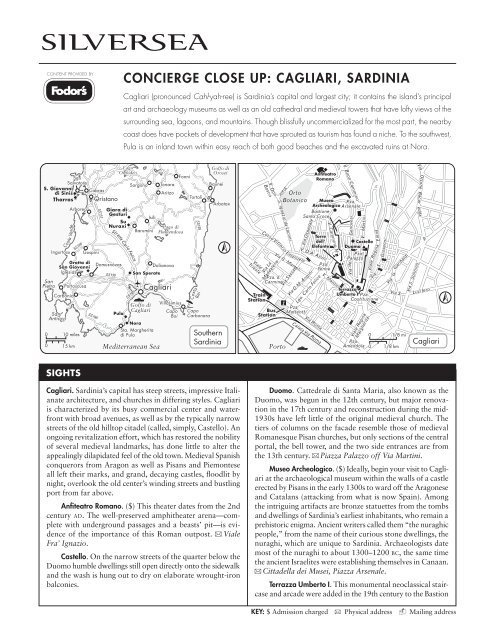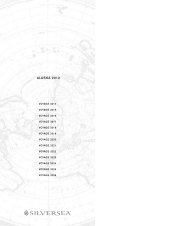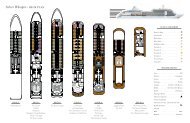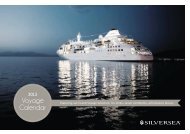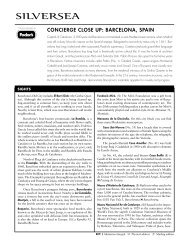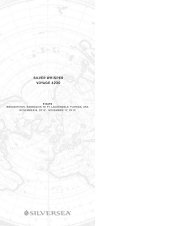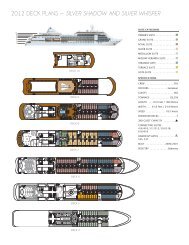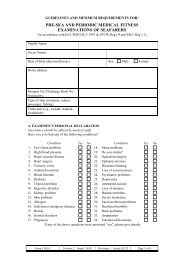Download Port Map and Information
Download Port Map and Information
Download Port Map and Information
You also want an ePaper? Increase the reach of your titles
YUMPU automatically turns print PDFs into web optimized ePapers that Google loves.
Via<br />
Content provided by<br />
'<br />
Concierge close up: Cagliari, Sardinia<br />
Cagliari (pronounced Cahl-yah-ree) is Sardinia’s capital <strong>and</strong> largest city; it contains the isl<strong>and</strong>’s principal<br />
art <strong>and</strong> archaeology museums as well as an old cathedral <strong>and</strong> medieval towers that have lofty views of the<br />
surrounding sea, lagoons, <strong>and</strong> mountains. Though blissfully uncommercialized for the most part, the nearby<br />
coast does have pockets of development that have sprouted as tourism has found a niche. To the southwest,<br />
Pula is an inl<strong>and</strong> town within easy reach of both good beaches <strong>and</strong> the excavated ruins at Nora.<br />
Lago<br />
Omodeo<br />
San<br />
Salvatore<br />
Sorgono<br />
S. Giovanni<br />
Cabras<br />
di Sinis<br />
Tharros<br />
Oristano<br />
San<br />
Pietro<br />
Costa Verde<br />
Ingurtosu<br />
Arborea<br />
Grotta di<br />
San Giovanni<br />
Iglésias<br />
<strong>Port</strong>oscusa<br />
Carbonia<br />
Sant'<br />
Antioco<br />
SS126<br />
0 10 miles<br />
0 15 km<br />
SS131<br />
Guspini<br />
SS195<br />
Giara di<br />
Gesturi<br />
Su<br />
Nuraxi<br />
Strada Carlo Felice<br />
Domusnóvas<br />
SS130<br />
see detail<br />
Pula<br />
SS195<br />
Isili<br />
Golfo di<br />
Cagliari<br />
Mediterranean Sea<br />
Tonara<br />
Aritzo<br />
Lago di<br />
Barumini Flumendosa<br />
San Sperate<br />
Nora<br />
Sta. Margherita<br />
di Pula<br />
Dolianova<br />
Cagliari<br />
Villasimius<br />
Capo<br />
Boi<br />
Fonni<br />
Tortoli<br />
Costa<br />
SS125<br />
Rei<br />
Capo<br />
Carbonara<br />
Golfo di<br />
Orosei<br />
Baunei<br />
Arbatax<br />
Southern<br />
Sardinia<br />
Viale<br />
Trieste Trieste<br />
V.<br />
Bosco<br />
Don<br />
Via Via La<br />
Maddalena<br />
Maddalena<br />
Viale<br />
S. Ignazio da Laconi<br />
Via G. Mameli<br />
Pza. d.<br />
Carmine<br />
<strong>Port</strong>o<br />
Via Sassari<br />
Pza.<br />
Matteotti<br />
Via Ospedale<br />
V. D.A. Azuni<br />
Via G.M. Angioi<br />
Lgo. Carlo Felice<br />
Via Roma<br />
Calata Via Roma<br />
V. Cammino N.<br />
V. Manno<br />
V. Buon Cammino<br />
Orto<br />
Botanico<br />
Museo Pza.<br />
Archeologico<br />
Arsenale<br />
Bastione<br />
Santa Croce<br />
Corso Vittorio Emanuele<br />
Train<br />
Station<br />
Bus<br />
Station<br />
Anfiteatro<br />
Romano<br />
Torre<br />
dell’<br />
Elefante<br />
Pza.<br />
Yenne<br />
Genovesi<br />
dei<br />
V. Martini<br />
Pza.<br />
Palazzo<br />
Viale<br />
Viale Regina<br />
Margherita<br />
Margherita<br />
Elena<br />
Castello<br />
Duomo<br />
Regina<br />
S.<br />
Via<br />
Terrazza<br />
Umberto I<br />
Pza.<br />
Costituzione<br />
Giovanni<br />
G.<br />
Via<br />
Via S.<br />
Garibaldi<br />
0<br />
1/8 mi<br />
Pza.<br />
Amendola<br />
0<br />
1/8 km<br />
Via<br />
Ottone Bacar<br />
edda<br />
Lucifero<br />
Via S. Sonnino<br />
Cagliari<br />
Sights<br />
Cagliari. Sardinia’s capital has steep streets, impressive Italianate<br />
architecture, <strong>and</strong> churches in differing styles. Cagliari<br />
is characterized by its busy commercial center <strong>and</strong> waterfront<br />
with broad avenues, as well as by the typically narrow<br />
streets of the old hilltop citadel (called, simply, Castello). An<br />
ongoing revitalization effort, which has restored the nobility<br />
of several medieval l<strong>and</strong>marks, has done little to alter the<br />
appealingly dilapidated feel of the old town. Medieval Spanish<br />
conquerors from Aragon as well as Pisans <strong>and</strong> Piemontese<br />
all left their marks, <strong>and</strong> gr<strong>and</strong>, decaying castles, floodlit by<br />
night, overlook the old center’s winding streets <strong>and</strong> bustling<br />
port from far above.<br />
Anfiteatro Romano. ($) This theater dates from the 2nd<br />
century ad. The well-preserved amphitheater arena—complete<br />
with underground passages <strong>and</strong> a beasts’ pit—is evidence<br />
of the importance of this Roman outpost. EViale<br />
Fra’ Ignazio.<br />
Castello. On the narrow streets of the quarter below the<br />
Duomo humble dwellings still open directly onto the sidewalk<br />
<strong>and</strong> the wash is hung out to dry on elaborate wrought-iron<br />
balconies.<br />
Duomo. Cattedrale di Santa Maria, also known as the<br />
Duomo, was begun in the 12th century, but major renovation<br />
in the 17th century <strong>and</strong> reconstruction during the mid-<br />
1930s have left little of the original medieval church. The<br />
tiers of columns on the facade resemble those of medieval<br />
Romanesque Pisan churches, but only sections of the central<br />
portal, the bell tower, <strong>and</strong> the two side entrances are from<br />
the 13th century. EPiazza Palazzo off Via Martini.<br />
Museo Archeologico. ($) Ideally, begin your visit to Cagliari<br />
at the archaeological museum within the walls of a castle<br />
erected by Pisans in the early 1300s to ward off the Aragonese<br />
<strong>and</strong> Catalans (attacking from what is now Spain). Among<br />
the intriguing artifacts are bronze statuettes from the tombs<br />
<strong>and</strong> dwellings of Sardinia’s earliest inhabitants, who remain a<br />
prehistoric enigma. Ancient writers called them “the nuraghic<br />
people,” from the name of their curious stone dwellings, the<br />
nuraghi, which are unique to Sardinia. Archaeologists date<br />
most of the nuraghi to about 1300–1200 bc, the same time<br />
the ancient Israelites were establishing themselves in Canaan.<br />
ECittadella dei Musei, Piazza Arsenale.<br />
Terrazza Umberto I. This monumental neoclassical staircase<br />
<strong>and</strong> arcade were added in the 19th century to the Bastion<br />
KEY: $ Admission charged E Physical address s Mailing address
of St. Remy (built by the Spaniards 400 years earlier). The<br />
great views of Cagliari, <strong>and</strong> a number of coffee shops, bars,<br />
<strong>and</strong> restaurants, make this a good place for a break after<br />
visiting the Castello quarter. EPiazza Costituzione.<br />
Torre di San Pancrazio. ($) The 1305 tower, part of the<br />
imposing medieval Pisan defenses, is just outside Cagliari’s<br />
archaeological museum, <strong>and</strong> it marks the edge of the Castello<br />
district. You can climb up the tower for a fabulous panorama<br />
of the city <strong>and</strong> its surroundings. Curiously enough, the tower’s<br />
back wall is missing, which allows you to see the series of<br />
wooden stairs <strong>and</strong> l<strong>and</strong>ings inside without climbing a step.<br />
EPiazza Indipendenza.<br />
Torre dell’Elefante. ($) The twin to the tower of San<br />
Pancrazio st<strong>and</strong>s at the seaward end of Cagliari’s bastions.<br />
Built in 1307, it was used as a prison in the 1800s. EVia<br />
Università.<br />
Nora. ($) The narrow promontory outside Pula was the<br />
site of a Phoenician, then Carthaginian, <strong>and</strong> later a Roman<br />
settlement. An old Roman road passes the moss-covered<br />
ruins of temples, a Roman theater, <strong>and</strong> an amphitheater<br />
now reserved for summer music festivals. Nora was a prime<br />
location—the Phoenicians scouted for good harbors, cliffs<br />
to shelter their craft from the wind, <strong>and</strong> an elevation from<br />
which they could defend themselves against attack. Extensive<br />
excavations have shed light on life in this ancient city from<br />
the 8th century bc onward. You can make out the channels<br />
through which hot air rose to warm the Roman baths; note<br />
the difference between the Carthaginians’ simple mosaic pavements<br />
<strong>and</strong> the Romans more elaborate designs. If the sea is<br />
calm, look under the clear waters along the shore for more<br />
ruins of the ancient city, submerged by earthquakes, rough<br />
seas, <strong>and</strong> erosion. Guided tours begin on the hour. j3 km<br />
(2 mi) south of Pula.<br />
Sant’Efisio. The little Romanesque church at the base<br />
of the Nora promontory plays a part in one of the isl<strong>and</strong>’s<br />
most colorful annual events. A four-day procession during<br />
the Festa di Sant’Efisio accompanies a statue of the saint all<br />
the way from Cagliari <strong>and</strong> back again, culminating in a huge<br />
parade down Cagliari’s main avenue. If you’re in Sardinia<br />
from May 1 to May 4, don’t miss it. j3 km (2 mi) south<br />
of Pula P070/9208473 CApr.–Sept., Sat. 3–6, Sun. 9:30–1<br />
<strong>and</strong> 3–7:30; Oct.–Mar., Sun. 9:30–noon <strong>and</strong> 3–5.<br />
Pula. Resort villages sprawl along the coast southwest of the<br />
capital, which has its share of fine scenery <strong>and</strong> good beaches.<br />
Home to one of Sardinia’s most magnificent stretches of<br />
coastline, Pula offers white-s<strong>and</strong> beaches, turquoise waters,<br />
placid coves, <strong>and</strong> powdery dunes. Beaches <strong>and</strong> lodging catering<br />
to summer crowds are concentrated 4 km (2½ mi) south<br />
of Pula, a little more than 1½ km (1 mi) south of Nora, in<br />
a conglomeration that makes up the town of Santa Margherita<br />
di Pula.<br />
Museo Archeologico Comunale. ($) The small archaeological<br />
museum has finds from excavations of a site at Nora,<br />
including amphoras, anchors, <strong>and</strong> inscribed stones, mostly<br />
dredged up from the sea. ECorso Vittorio Emanuele 67.<br />
San Sperate. Walls throughout this small town 20 km (12 mi)<br />
north of Cagliari have been brightened with murales (murals)<br />
by local artists <strong>and</strong> some well-known Italian painters. The<br />
murals were begun in 1968 <strong>and</strong> continue to be exp<strong>and</strong>ed,<br />
transforming the entire town into an open-air art gallery.<br />
Sardinian Cuisine<br />
Sardinian cuisine is sharply divided between hearty, meatbased<br />
dishes from the interior <strong>and</strong> Mediterranean seafood<br />
fare with Catalan <strong>and</strong> North African influences along the<br />
coast. Meat dishes are most commonly veal, roast agnello<br />
(lamb) <strong>and</strong> agnellino (baby lamb), or porcheddu (roast suckling<br />
pig, most often available at Easter). Cavallo, or carne<br />
equino (horsemeat), is also a common specialty of Sardinia;<br />
it’s generally served in the form of a bistecca (thin steak),<br />
which can be a bit chewy, but when properly grilled, also<br />
intensely flavored <strong>and</strong> delicious. Homemade pastas might be<br />
topped with a wild boar sauce. Finally, Italy’s original, <strong>and</strong><br />
best, pecorino cheese, made from sheep’s milk, comes from<br />
the rugged slopes of the interior.<br />
Looking for the unusual Try the ricci (sea urchins), which,<br />
unlike the Japanese uni, are served atop pasta. Bottarga,<br />
another prized Sardinian product, is a dried, cured tuna roe<br />
that’s best when shaved off a block directly onto spaghetti or<br />
with butter on crostini (thin slices of toasted bread). Foreign<br />
conquerors left their legacies of bouillabaisse (known here as<br />
zimino), paella, <strong>and</strong> cuscus (couscous), also called cashkà.<br />
Native pastas include malloreddus (small shells of bran pasta<br />
sometimes flavored with saffron), culurgiones (the Sardinian<br />
version of ravioli), <strong>and</strong> maccarones de busa (thick pasta<br />
twists). And crispy bread called pane carasau (carta di musica<br />
in Italian) is typical isl<strong>and</strong> fare. Prized around Italy, <strong>and</strong><br />
around the world, is Sardinia’s amaro di corbezzolo, a honey<br />
with a bouquet <strong>and</strong> taste primordially foresty, slightly bitter,<br />
<strong>and</strong> dazzlingly complex. It’s made by bees that suck nectar<br />
from a plant known as arbutus, the tree strawberry.<br />
Shopping<br />
Cagliari’s two best shopping streets, full of boutiques, clothing<br />
stores, <strong>and</strong> such, are Via Manno <strong>and</strong> Via Garibaldi, just<br />
up from the port. ISOLA (EVia Bacaredda 184 bVia Santa<br />
Croce 37/41) is a government-sponsored exhibition of artisan<br />
crafts; most of the work is for sale.<br />
Beaches<br />
Poetto Beach. Considered the hottest spot to relax in summer,<br />
Poetto Beach stretches from Cagliari to Quartu Sant’Elena<br />
<strong>and</strong> is lined with cafés, restaurants, shops, <strong>and</strong> parks. From<br />
the beach, you can admire the red flamingos that nest in the<br />
marshy reeds of the nearby Molentargius pond. j Take the<br />
Viale Diaz from Cagliari to the Viale Poetto.<br />
© 2010 Fodor’s Travel


